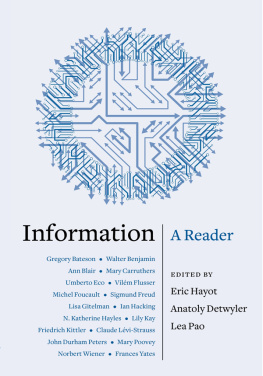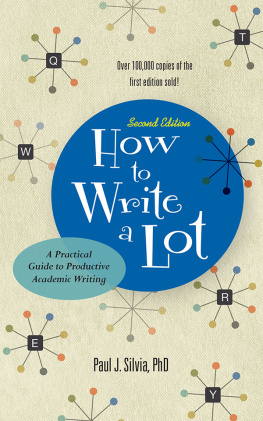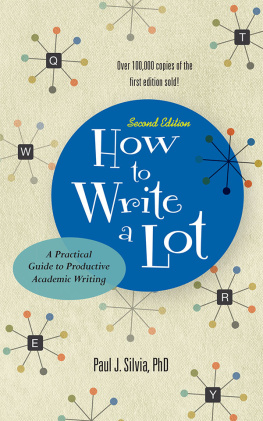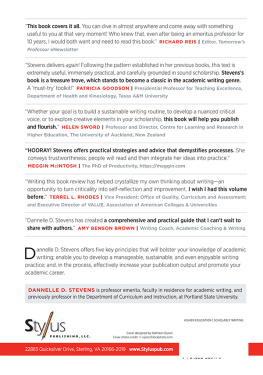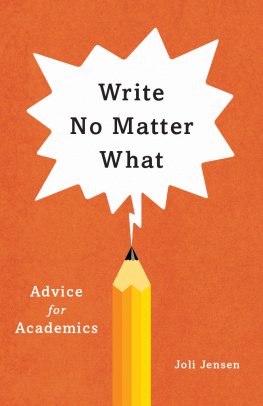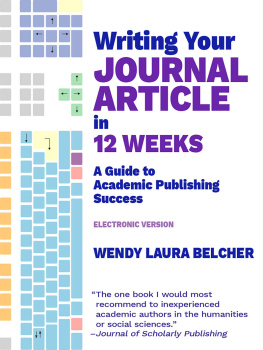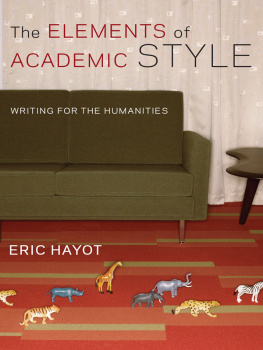The Elements of Academic Style
The Elements of Academic Style
WRITING FOR THE HUMANITIES
Eric Hayot
Columbia University Press
New York
Columbia University Press
Publishers Since 1893
New York Chichester, West Sussex
cup.columbia.edu
Copyright 2014 Columbia University Press
All rights reserved
E-ISBN 978-0-231-53741-4
Library of Congress Cataloging-in-Publication Data
Hayot, Eric, 1972
The elements of academic style : writing for the humanities / Eric Hayot.
pages cm
Includes bibliographical references.
ISBN 978-0-231-16800-7 (cloth : alk. paper) ISBN 978-0-231-16801-4 (pbk. : alk. paper) ISBN 978-0-231-53741-4 (e-book)
1. English languageRhetoricStudy and teaching (Higher) 2. Academic writingStudy and teaching (Higher) 3. HumanitiesStudy and teaching (Higher) 4. Critical thinkingStudy and teaching (Higher) I. Title.
PE1404.H3943 2014
808.066378dc23
2013048155
A Columbia University Press E-book.
CUP would be pleased to hear about your reading experience with this e-book at .
COVER DESIGN: Julia Kushnirsky
COVER IMAGE: Corbis
References to Web sites (URLs) were accurate at the time of writing. Neither the author nor Columbia University Press is responsible for URLs that may have expired or changed since the manuscript was prepared.
Contents
Writing is not the memorialization of ideas. Writing distills, crafts, and pressure-tests ideasit creates ideas. Active, engaged writing makes works from words. And these works belong, in turn, to the means that made them. They emerge from a process; they represent their becoming, and that emergence, in their final form.
Writing is, therefore, a kind of learning. I say so to oppose writing to dictation, to a conception of writing as a necessary but tedious step in the distribution and fixation of ideas. Conceiving of writing as the process whereby you put down thoughts you already have will give you a bad theory of what writing does and can do. As an idea of writings purpose, it tends to make for mediocre writers and mediocre prose. Writing as though you already know what you have to say hinders it as a medium for research and discovery; it blocks the possibilitiesthe openingsthat appear at the intersection of an intention and an audience, and constitute themselves, there, as a larger, complete performance. Active writing should not involve saying things you already understand and know, but instead let you think new things. And that is why, this book will argue, you cannot know what your ideas are, mean, or do until you set them down in sentences, whether on paper or on screen. It is also why the essay or the book you write will not be, if you are open and generous and unafraid, the essay or book you started with. To understand that process as a good thing and to develop a writing practice that helps you inhabit it: those are the two projects of this book.
Why read this book instead of any other book about academic writing? To answer that question, lets look at the three major types of books of this type that scholars in literary studies might be tempted to read:
1. Books addressing nonfiction style, especially at the level of the paragraph and the sentence, though often including a general ethos of writing as well. This category, the largest of the three, includes Strunk and Whites famous Elements of Style, Jacques Barzuns Simple and Direct, Arthur Plotniks Spunk & Bite, Roy Peter Clarks Writing Tools, William Zinssers On Writing Well, and Joseph Williamss Style. Most of these books assume a college-educated audience; almost all focus heavily on semi-journalistic forms like the magazine essay. None of them address scholarly writing at all. The exceptions are Helen Swords recently published Stylish Academic Writing, whose focus on major features of nonfictional style (storytelling, sentencing, jargon, etc.) draws from examples from across the academic disciplines, from the humanities to the hard sciences, and Michael Billigs Learn to Write Badly, which deals almost exclusively with academic writing in the social sciences.
2. Books focused on the psychological and working structures that help people write. Some of these are for lay audiences and undergraduate students, including Peter Elbows Writing Without Teachers and Natalie Goldbergs Writing Down the Bones. Others focus specifically on the kinds of problems the academic professoriate faces, such as Robert Boices Professors as Writers, Paul Silvias How to Write a Lot, and Joan Bolkers Writing Your Dissertation in Fifteen Minutes a Day (a sentence from the introduction of that book: I dont actually know anyone whos [written a dissertation] in only fifteen minutes a day.).
3. Books that cover the formal patterns and structure necessary to produce specific academic genres. Books like William Germanos From Dissertation to Book or The Thesis and the Book, edited by Eleanor Harman and her colleagues, follow this format. In this category you will also find something like Wendy Belchers excellent Writing Your Journal Article in Twelve Weeks, which includes advice about work patterns alongside its highly detailed analysis about the journal article as a genre.
The Elements of Academic Style covers ground from all three of these areas. The first part of the book, Writing as Practice, frames the discussion of academic style by talking about how writing is currently taught (implicitly and explicitly) in graduate school. It goes on to offer advice about psychological and social structures designed to promote writing and looks at the institutional contexts that govern the major genres in humanistic style (mainly the kind of thing that appears in books of the second and third type). I also present an ethos of writinga way of thinking about what writing does, and how it should workthat aims to help you understand why you might write a certain way, or why I recommend certain structural strategies or sentence-level choices. Together, these pieces of advice guide you toward an understanding of writing as an extensively lived practice governed by (and governing in turn) a wide variety of behaviors, attitudes, institutional patterns, and personal and social regimes.
The books second part, Strategy, examines large-scale structures that govern the production of scholarship in literary and cultural studies, including introductions, conclusions, structural rhythm, transitions, and so on. The third part, Tactics, covers lower-level aspects of writing practice: footnotes, figurative language, diction, ventilation, and a variety of other concepts that usually operate below the level of a writers conscious activity. I know of no other book that gives this kind of detailed guidance for scholarly writers in the humanities (Helen Swords book comes closest, but flies at a higher altitude). Its in the detailed, writing instruction about scholarshipbreaking down the Uneven U paragraph, demonstrating how to show your iceberg, laying out a continuum of metadiscursive practice, or working through three major types of transitions, all of these specifically focused on scholarship in literary and cultural studiesthat this book offers things you cant find anywhere else.
The Elements of Academic Style is mostly written for scholars in literary and cultural studies, whether graduate students or members of the faculty. At its most particular, it is a book about how to write theory, or rather, how to write literary scholarship in the mode that was born out of the influence of philosophy and cultural studies on literary criticism over the last three decades. I make no guarantees as to its general applicability! Might these lessons only work for someone with my idiosyncratic educational trajectory; my Continental, soupless childhood; or my suspiciously comedic history of psychological disasters? Perhaps. But perhaps again you and I share, happily, a history of psychological disasters. In which case what works for me may well work,


